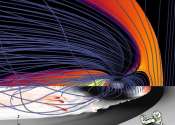Nightside barrier gently brakes 'bursty' plasma bubbles
The solar wind that pummels the Earth's dayside magnetosphere causes turbulence, like air over a wing. Physicists at Rice University have developed new methods to characterize how that influences space weather on the nightside.









